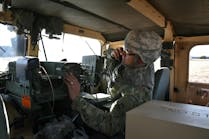KIRTLAND AIR FORCE BASE, N.M. - U.S. Air Force space experts are asking Braxton Technologies in Colorado Springs, Colo., to build the ground control segment of an upcoming research project to enable U.S. satellite navigation systems to operate reliably amid electronic jamming, spoofing, and cyber attacks expected in future military conflicts.
Officials of the Air Force Research Laboratory at Kirtland Air Force Base, N.M., announced a $9.5 million contract to Braxton Technologies to provide the Navigation Technology Satellite (NTS)-3 ground control segment.
The NTS-3 project will use space- and ground-based systems to develop and demonstrate advanced global positioning system (GPS) technologies that are resilient in contested environments. U.S. defense officials believe that conditions in future military conflicts could deny or severely degrade the use of GPS navigation systems.
Braxton Technologies experts will provide the NTS-3 ground control segment to support orbit operations, while demonstrating and maturing innovative and affordable satellite navigation ground-based command and control capabilities to ensure resilient positioning, navigation, and timing in contested and denied environments.
Company experts also will demonstrate satellite ground-control technologies that eventually could be used in future GPS ground-control systems. They will use the Multi-Mission Space Operations Center (MMSOC) open architecture standard, as well as the Air Force Satellite Control Network (AFSCN) for primary direct and secure communications with the future NTS-3 space payload.
The NTS-3 project will look into different ways to reconstitute the ground control segment in the event of an attack; experiment with automated and lights-out operations; demonstrate space vehicle command and control through commercial ground antennas; show compatibility with the Enterprise Ground System (EGS) standards and the Joint Space Operations Center (JSpOC) Mission System (JMS); and investigate modern processes to manage cyber risks.
NTS-3 builds on 40 years of GPS developments, and should help shape the future of military satellite navigation capabilities in tested environments. NTS-1 and NTS-2 were flown in 1974 and 1977 respectively, and qualified the rubidium and cesium clocks that form the backbone of today's modern GPS architecture.
On this contract, Braxton Technologies will do the work in Colorado Springs, Colo., and should be finished by June 2022.
FOR MORE INFORMATION, visit Braxton Technologies online at www.braxtontech.com, or the Air Force Research Laboratory-Kirtland at www.kirtland.af.mil/Units/AFRL-Space-Vehicles-Directorate.

John Keller | Editor
John Keller is editor-in-chief of Military & Aerospace Electronics magazine, which provides extensive coverage and analysis of enabling electronic and optoelectronic technologies in military, space, and commercial aviation applications. A member of the Military & Aerospace Electronics staff since the magazine's founding in 1989, Mr. Keller took over as chief editor in 1995.



